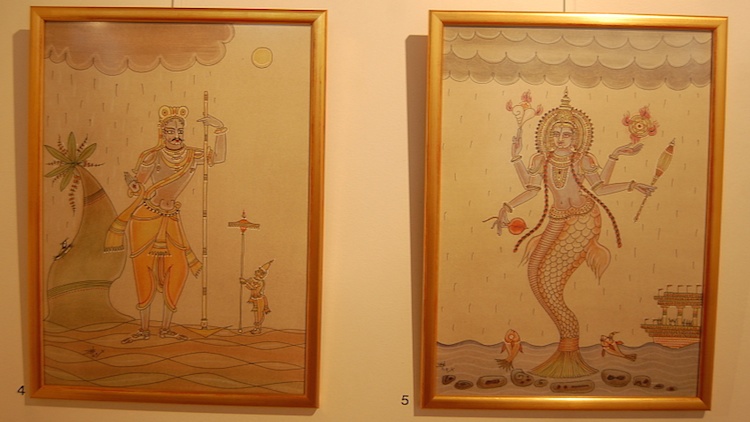Belgium’s Museum of Sacred Art Shows New Galleries
By Madhava Smullen | Aug 08, 2014

The Museum of Sacred Art (MOSA) at the ISKCON community of Radhadesh in Belgium has launched three new galleries, and has more exciting plans in the pipeline.
Funded and opened in 2009 by Mahaprabhu Das, who grew up in a family of artists, MOSA introduces Radhadesh visitors to Krishna consciousness through art.
The museum features several permanent pieces including three large framed wooden depictions of Lord Krishna’s universal form, Lord Ramachandra, and the Dasavatar (Krishna’s ten incarnations).
But its main offering is an annually rotating roster of exhibits that include sculptures, paintings, photography, video, and other art mediums.

A piece on Lord Jagannath from Timeless Art by Poosapati Parameshwar Raju
This year’s three new galleries were revealed on May 17th. The day began with a VIPs only event from 11am to 3pm, drawing some 150 local dignitaries, politicians and ambassadors.
First came a reception and cultural program, including musical performances by sitarist Subrata De and legendary Bansuri flute player Hariprasad Chaurasia.
Indian Ambassador to Belgium and the European Union Manjeev Singh Puri then ceremonially unveiled a new monument featuring lifesized murti forms of Lord Vishnu, Lord Nrismhadeva, and Lord Varahadeva donated by the Indian Embassy of Brussels.
The main event followed, with Puri opening the new MOSA exhibitions as the other VIPS followed and viewed the art for the first time.

Dignitaries including Indian Ambassador to Belgium Manjeev Singh Puri (left in turban) offer ceremonial coconuts as they open the new galleries
Two of the exhibits were housed in the larger of MOSA’s two buildings. One was Raghupati Bhat’s Enduring Epics, a series of paintings that colorfully fused the contemporary with the traditional to tell the stories of Indian’s great classics the Ramayana, the Mahabharata, and the Bhagavata Purana
The other was Timeless Art, consisting of elegant and exotic calligraphic images by Poosapati Parameshwar Raju, depicting the Ramayana and the pastimes of Lord Krishna.
Raju’s exhibit also included his series on World Faiths, bringing together symbols from Christianity, Sikhism, Islam, Zoroastrianism and more to highlight the similarities between different faiths and inspire greater understanding and appreciation amongst them.
After viewing Raju’s exhibit, visitors could stop at a table where the artist himself expertly inscribed their names in calligraphy for them as they looked on in delight.

Artist Poosapati Raju creates a calligraphy piece for the Indian Ambassador
They then moved on to the second, smaller MOSA building to view Looking Within, a more abstract gallery by Shobha Broota. Here, through paint and other mediums, the artist depicted her personal spiritual journey of soul searching and meditation.
“We combine it with live bhajans daily, so that the whole atmosphere of the museum is more meditative,” says general manager Raya Ramananda Das.
After the VIPs concluded their visit with lunch at the Radhadesh restaurant, the community and the museum then opened its doors to around 700 people from the local municipality.
“Having the public there was good in terms of connecting to and integrating in the area, which is of course very important for the future of Radhadesh,” says Raya Ramananda.

Local dignitaries admire Shobha Broota’s exhibition ‘Looking Within’
The future of MOSA is bright too. The opening of a new branch in Villa Vrindavana, Italy is planned for next spring, with a stunning Mahabharata painting exhibition already completed.
And Forms of Devotion, a huge traveling MOSA exhibition featuring the devotional works of no less than 100 artists, will launch at the Lalit Kala Akademi in New Delhi on March 21st 2015, then hit the road and appear in museums across the world.
“We will also release a documentary about the lives of some of the artists and how their different backgrounds – urban, rural, rich, poor – affect their art, as well as two 500-page catalogs of the exhibits,” Raya Ramananda says.
He explains that there are also long-term plans over the next ten years to house the whole collection permanently in a purpose-built museum in either Mayapur, India, or Radhadesh.

MOSA Director Mahaprabhu Das (right) meets artist Poosapati Parameshwar Raju
Meanwhile, the original MOSA in Radhadesh continues to draw 30,000 visitors every year, who see it as part of the community’s guided tours, and are frequently moved by it.
“One lady who visited recently had just gone through a health crisis, and she was so touched by the art that there were tears running down her cheeks,” says Raya Ramananda. “Many take catalogs of the exhibits home with them so that the experience they had in Radhadesh won’t fade over time. You can see that the museum has a very positive impact on people.”














